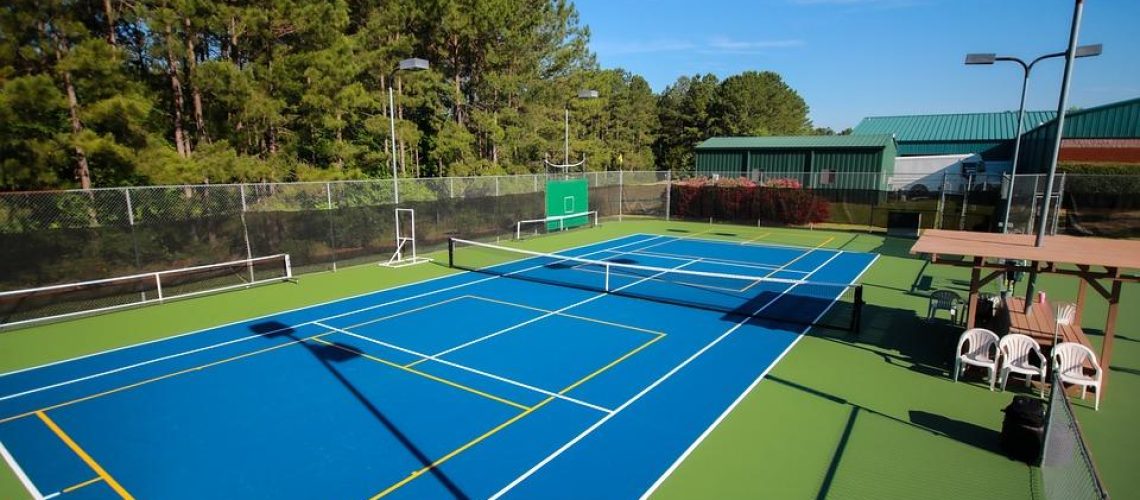We may earn money or products from the companies mentioned in this post.
Introduction

Have you ever wondered what happens when a tennis match gets suspended? It’s not uncommon for matches to be interrupted due to various reasons, such as bad weather or player injuries In this article, we’ll explore the concept of a suspended tennis match and delve into the common reasons behind these suspensions
Explanation of Tennis Match Suspension
A suspended tennis match refers to a situation where play is temporarily halted and the match is put on hold This means that the players leave the court and resume their game at a later time It’s important to note that a suspension differs from a cancellation, as matches that are canceled are not resumed
Common Reasons for Suspensions in Tennis Matches
Tennis matches can be suspended for various reasons, which can impact both professional tournaments and friendly matches alike Let’s take a closer look at some of the most common causes:
-
Inclement Weather:
One of the primary reasons for suspending a tennis match is adverse weather conditions Rain, thunderstorms, extreme heat, or strong winds can make it unsafe or impractical for players to continue playing -
Poor Court Conditions:
If the court becomes waterlogged due to heavy rain or if there are issues with its maintenance like slippery surface or damaged nets, officials may decide to suspend the match until necessary repairs can be made -
Injury or Illness:
If a player sustains an injury during the course of play or falls ill, officials may suspend the match to allow them time to recover or seek medical attention This ensures fairness and player safety -
Lack of Light:
Matches played outdoors often rely on natural light If the darkness sets in and visibility becomes compromised, officials may decide to suspend the match until the following day or until suitable artificial lighting can be arranged -
External Interruptions:
Occasionally, matches can be suspended due to external factors beyond the players’ control This could include power outages, security concerns, or any other unforeseen circumstances that make it impossible to continue play
These are just a few examples of why tennis matches get suspended Each situation is unique and requires officials to make well-informed decisions based on player safety and fairness considerations
In conclusion, understanding what happens when a tennis match gets suspended can help tennis enthusiasts appreciate the challenges faced by players and organizers alike Whether it’s bad weather, injuries, or other unforeseen circumstances, suspensions are a necessary part of the game that ensure fair and safe competition
The Process of Suspending a Tennis Match

When it comes to tennis matches, there are various factors that can lead to the decision of suspending play These factors range from weather disturbances to player injuries or medical emergencies on court, as well as external disruptions Let’s take a closer look at each of these factors:
1 Weather Disturbances
One of the most common reasons for suspending a tennis match is due to weather disturbances such as rain, extreme heat, or high winds Rain delays can render the court unplayable and make it unsafe for the players to continue competing In some cases, even if the rain stops, the court may remain too wet and slippery for play to resume immediately
Additionally, in professional tennis, there is a heat rule in place to protect players from extreme temperatures When the temperature reaches a certain threshold determined by tournament organizers, play may be suspended or delayed to ensure player safety and prevent heat-related illnesses
2 Player Injuries or Medical Emergencies
Player injuries or medical emergencies that occur on court can also lead to the suspension of a tennis match In such situations, medical timeouts may be allowed during a match to provide necessary treatment and assessment for injured players These timeouts allow players time to receive medical attention without penalizing them
In more severe cases where player safety and well-being are at risk, play will be stopped altogether until appropriate measures have been taken to address the situation Whether it’s an acute injury or a sudden health issue, ensuring immediate care is provided takes precedence over continuing with the match
3 External Factors Disrupting the Game
In addition to weather conditions and player-related incidents, external factors can also disrupt a tennis match Crowd disturbances, technical issues, or security concerns may arise unexpectedly and require play to be suspended
For example, if there is a disturbance in the crowd that poses a potential threat to player safety or disrupts the focus of the competitors, officials may halt play until the situation is under control Similarly, technical issues with equipment or court facilities can render fair play impossible and necessitate a suspension until the problem is resolved
In summary, the decision to suspend a tennis match is based on various factors including weather disturbances like rain or extreme heat, player injuries or medical emergencies on court, and external disruptions such as crowd disturbances or technical issues These decisions prioritize player safety and fair competition while ensuring that all necessary precautions are taken to maintain an optimal playing environment
Resuming Play After Suspension: Rules and Procedures

When a tennis match is suspended due to various circumstances such as weather conditions or player injuries, there are specific rules and procedures in place to ensure a fair and smooth continuation of the game These guidelines are set by major governing bodies like the ATP, WTA, and ITF to maintain consistency across tournaments
Tournament Regulations on Resuming Suspended Matches
Under the guidance of governing bodies, tournaments establish regulations regarding the resumption of matches that have been suspended One important aspect is determining the timeframe within which the match must be resumed This helps maintain fairness for both players involved
Additionally, tournament organizers allocate practice time before restarting play This allows players to warm up and get back into their rhythm after an extended break It ensures that both competitors have an equal opportunity to perform at their best when play resumes
Player Rights During the Suspension Period
During a suspension period, players are entitled to certain rights that support their physical and mental well-being They have access to coaches who can provide guidance and strategies during breaks in play Rest areas are also made available for players to relax and regroup between sets or during longer interruptions
Furthermore, physiotherapists or medical professionals may be present on-site to attend to any injuries or ailments that arise during the suspension period This ensures that players receive appropriate care and can continue playing without compromising their health
Impact on Spectators Attending the Event
Suspensions can also impact spectators attending the tennis event Ticket policies related to suspended matches vary depending on tournament organizers’ guidelines Some tournaments may offer refunds or exchanges for tickets if a match is not completed due to a suspension
Moreover, communication channels for schedule updates play a crucial role in keeping spectators informed Tournament organizers often provide real-time notifications through various platforms, such as official websites or mobile applications This enables spectators to adjust their plans accordingly and stay updated on match resumption times
In conclusion, resuming play after a suspension involves adhering to tournament regulations set by governing bodies, ensuring player rights are upheld during the break, and considering the impact on attending spectators These measures contribute to maintaining fairness and providing an enjoyable experience for all involved in the tennis event
Consequences of Suspension on Players’ Performances and Tournament Outcomes

Suspensions in sports can have significant consequences on players’ performances and tournament outcomes Let’s explore some of the impacts that suspensions can have on both players and the overall schedule of a tournament
Impact on Players’ Physical Condition and Strategies due to Extended Breaks in Play
1 Returning to the court after a suspension can require adjustments from athletes The extended break in play disrupts their rhythm, conditioning, and muscle memory Players may need time to regain their form and adapt to match situations again
2 Besides physical adjustments, players also need mental strength to maintain focus throughout interruptions caused by suspensions Staying mentally sharp during breaks can be challenging, as it requires athletes to manage their emotions and keep their strategies intact
Effects on Tournament Schedules and Potential Conflicts with Other Events
1 Suspensions pose rescheduling challenges for tournament organizers They must navigate logistical complexities, such as finding suitable slots for postponed matches or accommodating multiple matches within limited time frames
2 For players participating in multiple events like singles, doubles, or mixed doubles, suspensions can create conflicts with other tournaments they are involved in Juggling schedules becomes tricky as they strive to meet commitments across different competitions
Case Studies: Famous Tennis Matches Affected by Suspensions and Their Outcomes
1 Tennis history is replete with examples of notable suspended matches that had lasting impacts on the sport’s narrative These instances often serve as lessons learned for both players and administrators
2 By examining these famous cases closely, we gain insights into how suspensions shaped the current rules surrounding match suspensions Studying the outcomes of these matches helps ensure fair play and appropriate decision-making in similar situations going forward
Useful Links

What Are the Essential Rules for Online Betting on Tennis?
Play is currently suspended… – US Open Tennis …
Anyone know what happens when a tennis match gets …
What Happens If a Tennis Match is Interrupted by Rain –
Tennis Betting Rules – Bovada Sports Help Center
Does Interrupting a Match Impact the Outcome?
Tennis Rules
Your guide to when and how a match may be safely …
Match fixing in tennis
Definitions | USTA Mississippi
TENNIS RULES
What Does Suspended Mean in Tennis
Tennis FAQ
Australian Open heat policy: When are matches suspended?
The match has been interrupted. Is the bet voided?
May 15
BNP Paribas Open play resumes after rain delay
NCAA Men’s Tennis Quarterfinal Match Suspended Due to …
Tennis Rules
Carlos Alcaraz spares ball kid from heavy rain in classy …






